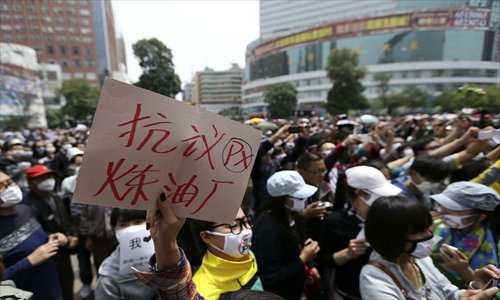Public demands transparency in plant protests

Protests over the weekend against two large petrochemical projects built in close proximity to residential areas in Southwest China's Yunnan and Sichuan provinces again sparked questions about the opaque process of environmental impact assessments.
Thousands of residents in Kunming, the capital of Yunnan, gathered in the city center on Saturday afternoon to oppose a large oil refinery project by the China National Petroleum Corporation (CNPC).
The project, located in the nearby city of Anning, would have the capacity to process 10 million tons of crude oil per year.
The project is part of a national strategic plan to transport imported crude oil through the China-Myanmar oil pipeline to Southwest China to relieve energy shortages. A statement from the Anning government tried to reassure the public that it uses front-edge pollution control technologies and that the project had passed a strict environmental impact assessment (EIA).
However, many residents worried that a potentially hazardous paraxylene (PX) project would follow and expressed their opinions using banners that read "No PX in Kunming" or "Keep the Spring City alive."
"This project is built upwind of Kunming and is close by, which would cause air and water pollution to a city already suffering from severe drought and poor drainage ability," Jiajia, a local resident, told the Global Times.
Police were at the scene but reportedly had no conflict with the protesters. However, both the Kunming and Anning governments could not be reached for comment as of late Sunday.
Another CNPC oil refinery project in Pengzhou, Sichuan, also triggered opposition due to air pollution concerns among locals and residents in Chengdu, 36 kilometers away. Yet a planned protest was allegedly thwarted Saturday.
"The streets were full of police saying that an earthquake drill was being staged," Lei Tong, a Chengdu resident, told the Global Times.
The Sichuan branch of the CNPC introduced six key air pollution control measures Sunday, noting that better quality gasoline provided by the project would actually improve air quality.
The city government also announced on April 29 that the project would not start operation if it failed a final environmental assessment involving public participation and would be halted at any time during production if environmental issues happen.
Despite government statements, petrochemical projects, especially those involving the controversial PX, have become notorious and have sparked several massive protests in recent years.
"PX is a basic petrochemical raw material and is safe if proper protocols are followed. People are scared because there is a lack of access to information or participation in the projects," Jin Yong, a leading petrochemical expert at Tsinghua University, told the Global Times.
"The protests suggest increased public awareness of environmental protection, but also revealed poor public involvement in the decision-making process of large petrochemical projects before construction," said Li Runsheng, vice director of China Petroleum and Chemical Industry Federation.
Information disclosure for both projects was opaque and came out late under public pressure.
"We met with the project committee in April, which was the first public communication event after the construction for two years," a staffer of Green Kunming, a local environmental NGO, told the Global Times.
"Public rights to information access, participation in environmental policies and judicial remedies are key to solving these situations and preventing the EIA from being manipulated by developers and officials," Ma Jun, director of the Institute of Public and Environmental Affairs, told the Global Times.
"We did not protest for the sake of protest, but we want to make our own decision based on a full grasp of the risks, benefits, responsible parties and compensations through hard data," said a Kunming protester surnamed Wang.
Related articles:
Public trust key to environmental disputes